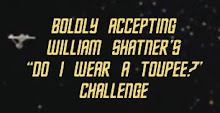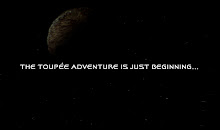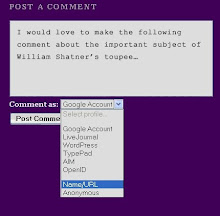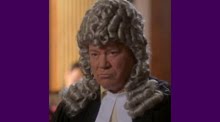(Source: rjbuffalo.com)
"The Indestructible Mr. Gore" is a first season episode of a short-lived 1959-60 television series called Sunday Showcase. Much like the far better known Studio One, it was an anthology series of teleplays (though it also included comedies and musicals), and often featured writing, acting and directing (including John Frankenheimer and Sidney Lumet) talents who would go on to achieve widespread fame and recognition. "The Indestructible Mr. Gore", broadcast in color, was written by celebrated American author Gore Vidal, who also appears in the episode as an on-screen narrator.
Fred Kaplan's eponymous biography Gore Vidal (available on Google books - see pages 467-468) notes that "The Indestructible Mr. Gore" was "one of the last television dramas broadcast live..." It also adds that the program, screened on December 13, 1959 "deserved and received superb reviews".
(Click for larger view)
Asides from Vidal as narrator, the episode stars William Shatner, Inger Stevens and E.G. Marshall (who also acted alongside Bill Shatner in Vanished, 1971, and Disaster on the Coastliner, 1979). The story centers on Gore Vidal's real-life blind grandfather, Senator Thomas Gore, portrayed by William Shatner. According to IMDB:
Senator Thomas Gore (source:Wikipedia)
"In the early 1890s, Thomas seeks employment in the office of a Texas judge. During the interview Thomas reveals that it is his life's ambition to become a United States Senator. He also informs Judge Wingate [Eg.G. Marshall] that he is completely blind."
On a side note: Thomas Gore would indeed overcome his blindness and serve as a US Senator from 1931-1937, chiefly under wheelchair-bound US president Franklin D. Roosevelt.
William Shatner's portrayal of the blind but ambitious young Gore was called "outstanding" by The New York Times. The Los Angeles Times, meanwhile, called the episode an "expertly handled hour", and lauded the performances of the three stars performing alongside Gore Vidal.
(Source: rjbuffalo.com)
We wish we could offer our own review of this episode. But unfortunately the master tapes of this show were erased by NBC in 1973. Thus, it may have been wiped from existence. In the UK, this phenomenon has given rise to the name "Missing Believed Wiped". Basically, until as late as 1980, TV stations were wiping tapes of previously broadcast programs to free-up space. Reruns? VHS? DVD? Historical value? No-one seemed to give a hoot.
A brief detour: Perhaps the most publicized wiping and subsequent re-locating of lost elements surrounds the BBC's Doctor Who series. Dedicated fans have spent years tracking down episodes believed wiped by the BBC, locating copies in places as afar as Nigeria. This also led to some fascinating restoration technologies being utilised (ever heard of "chroma dots"?). But some episodes are still missing.
Even if, like us, you have no idea what Doctor Who is supposed to be about as a dramatic presentation, the story of how so many of its episodes were lost and then re-found is certainly worth looking at by anyone interested in film and television.
Meanwhile, the website rjbuffalo.com has an extensive section on the television works of Gore Vidal. It features plenty of stories of similarly lost episodes and calls for readers to help track down potential kinescope (a film camera recording video footage off a TV) recordings that may or may not still exist somewhere. Its section on "The Indestructible Mr. Gore" notes:
"This is one of the most sought-after of all lost television programs [emphasis ours]. There MUST be copies around somewhere, and whoever has them probably doesn’t realize that they’re anything special.."
"That is what happened to the 2 inch color quad. There is the possibility, of course, that other 2 inch color quad copies, recorded by stations that wished to delay the broadcast, might still exist. The chances, though, are vanishingly small. It is more likely that a kinescope, probably b&w, would still survive somewhere...If you have any leads, any leads at all, on where this program might be located, please contact me IMMEDIATELY. It is of utmost importance that this program be found, rescued, restored, and released."
We contacted "rj" and confirm that he is still very much interested in tracking down this episode...
Fortunately for us, the story does not end there. Two images of "The Indestructible Mr. Gore" do survive - one of which we believe to be of major toupological interest.
The first, reprinted at rjbuffalo, is from a Variety TV listing of the broadcast (full image atop this post). Obviously, magazines cannot show pictures from live broadcasts that have not yet aired. So the image is possibly from a dress rehearsal or publicity shoot. It shows Bill Shatner very likely wearing his easily identifiable "Jim Kirk lace". (Note the lush and rounded, rather than v-shaped, hairline at the side of the forehead.)
By 1959, this toup was one the actor was, we believe, wearing full-time for TV broadcasts. The first hitherto identified usage is back in May 1958's Suspicion: "The Protégé".
William Shatner in "The Protégé" (1958)
But as we noted in our analysis of Kraft Mystery Theater: "The Man Who Didn't Fly", which aired later in July 1958, lengthening, clever combing and heavy spraying could still at this point yield a viable (from the standpoint of concealing thinning hair) toupless performance.
But to the keen observer, the clues that Bill Shatner's hair was rapidly thinning, in particular in the crown area and moving up towards the front of the head, were evident as far back as 1956:
Goodyear Television Playhouse:"All Summer Long" (1956)
And even more so by 1957:
Alfred Hitchcock Presents:"The Glass Eye" (1957)
All of which brings us to the second available photo of "The Indestructible Mr. Gore". We spotted a low resolution version on the rjbuffalo site, taken from a 1994 book written by Gore Vidal entitled Screening History. Our staff immediately set about locating a copy of the book and subjecting the photograph in question to the full range of our latest touposcopical equipment.
The conclusion reached by the Department of Toupological Determinations, and subsequently affirmed by the Toupological Review Board, was a startling one: this was Bill Shatner in 1959 without his toupee. That would date this picture as the last toupless image we have come across thus far. Previously, the last likely toupless picture we had was a mid-1959 rehearsal image from a TV series called Tactic.
(Bill Shatner rehearses Tactic. See here for more)
Before we get into the details of how the call was made, there is the question of why this photo differs from the first one, which is most certainly one in which Bill Shatner is touped-up. Obviously, we can't say for sure. Is it possible that Bill Shatner went toupless for the actual broadcast? It's possible (though given the actor's thinning hair, we suspect only external circumstances, like a damaged lace, would have forced such a decision upon Bill Shatner). The other, perhaps more viable option is that this is some kind of unofficial rehearsal picture. Unlike the first image, it is not necessarily intended for public release. We can only speculate...
But what is evident is that Bill Shatner's hair is very different between the two pictures. In the second image, the characteristic curve that follows the upper sides of the hairline is absent. Instead, we have not only a normal v-shaped recession, but also a line indicating a parting of the hair. Along the parting line, we see an area of Bill Shatner's scalp that is usually fully concealed (and certainly not visible if wearing a "Jim Kirk lace").
Overall, our team divided the image into four specific Areas of Toupological Interest (ATI). This yielded ATI 01, ATI 02, ATI 03, and ATI 04.These areas were then studied and compared with available images of Bill Shatner both touped-up and toupless. Staff recorded the following observations:
ATI 01 - this suggests long, thinning hair.
Side-parted and quite compressed - perhaps as a result of wearing a toupee on top or hair treated with hair oil or other product.
ATI 02 - (the area we discussed a little earlier).
Side-parting. V-shape. No rounded strands of "Jim Kirk lace" sprouting up from this area. Scalp visible, extending towards mid-section of head.
(Jim Kirk lace "rounded" side of hairline. Source: Trekcore.)
ATI 03 - observable thinning.
Hair of notably different density than that visible at the sides of Bill Shatner's head. Shortening effect at rear, thinning "comb-back" clump.
("All Summer Long". Note lightened, thinning "comb-back" at rear. Beyond is "missing" section - see ATI 04)
ATI 04 - characteristic "Jim Kirk lace" smooth curve of hair arching around back/crown of head absent. Something "missing".
The "Jim Kirk lace" creates a very particular smooth, curved look to the back of the head.
(images from Judgment at Nuremberg, 1961)
Conversely, later-stage toupless performances show this curve to have the "missing" area, in which the combed-down hair was not sufficient to maintain the fluidity of this arch.
It's a sort of "hen peck" effect. Something has been "gnawing" at the back, leaving an area of disruption.
A similar effect was observed in the "The Indestructible Mr. Gore" image. The rear area does not appear to follow the smooth, thick curve indicative of a "Jim Kirk lace". Something at the back is noticeably missing.
Thus, for the above reasons, as well as due to some more detailed sub-toupular readings detected by our touposcopes...
...the William Shatner School of Toupological Studies (WSSTS) "felt that enough evidence exists to conclude that the image in question is very likely one in which William Shatner is not wearing a toupee, or in the modern vernacular, is 'toupless'". The full 567-page report can be obtained by writing to the WSSTS.
Toupee delivery delight? Via Twitter.














































